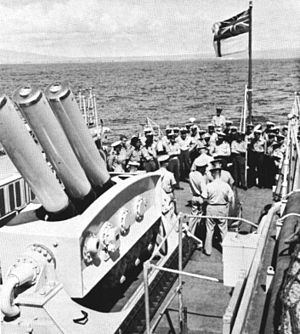Our website is made possible by displaying online advertisements to our visitors.
Please consider supporting us by disabling your ad blocker.
Limbo (weapon)
| Limbo | |
|---|---|
 A Limbo mortar on HMNZS Taranaki (F148) | |
| Type | Anti-submarine mortar |
| Place of origin | United Kingdom |
| Service history | |
| In service | 1955–1980s |
| Used by | Royal Navy Royal Australian Navy Royal Canadian Navy Libyan Navy South African Navy |
| Wars | Falklands War |
| Production history | |
| Designer | Admiralty Underwater Weapons Establishment |
| Specifications | |
| Crew | 3 |
| Shell | 400 lb depth charge |
| Calibre | 12 inches (30 cm) |
| Barrels | 3 |
| Effective firing range | 400 yards (366 m) to 1,000 yards (914 m) |
| Warhead | Minol |
| Warhead weight | 94 kilograms (207 lb) |
Detonation mechanism | Proximity and/or time |
Guidance system | Type 170 sonar |
Limbo, or Anti Submarine Mortar Mark 10 (A/S Mk.10), was the final development of the forward-throwing anti-submarine weapon Squid, designed during the Second World War[1] and was developed by the Admiralty Underwater Weapons Establishment in the 1950s.[2]
Limbo was installed on the quarterdeck of Royal Navy escort ships from 1955 to the mid-1980s, Australian-built Daring-class destroyer and River-class destroyer escorts. Limbo was widely employed by the Royal Canadian Navy, being incorporated into all destroyer designs from the late 1950s to the early 1970s, including the St. Laurent, Restigouche, Mackenzie, Annapolis and Iroquois classes and the Type 12 President Class frigates built for the South African Navy in the 1960s.
- ^ British ASW weapons
- ^ Bogart, Charles H. (2010). "An Anti-submarine Weapon: The Limbo Mk NC 10 Mortar". Warship International. XLVII (4): 359–362. ISSN 0043-0374.
Previous Page Next Page


